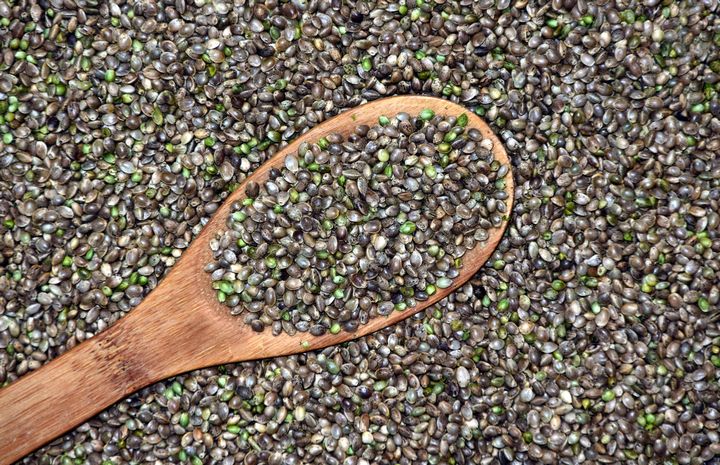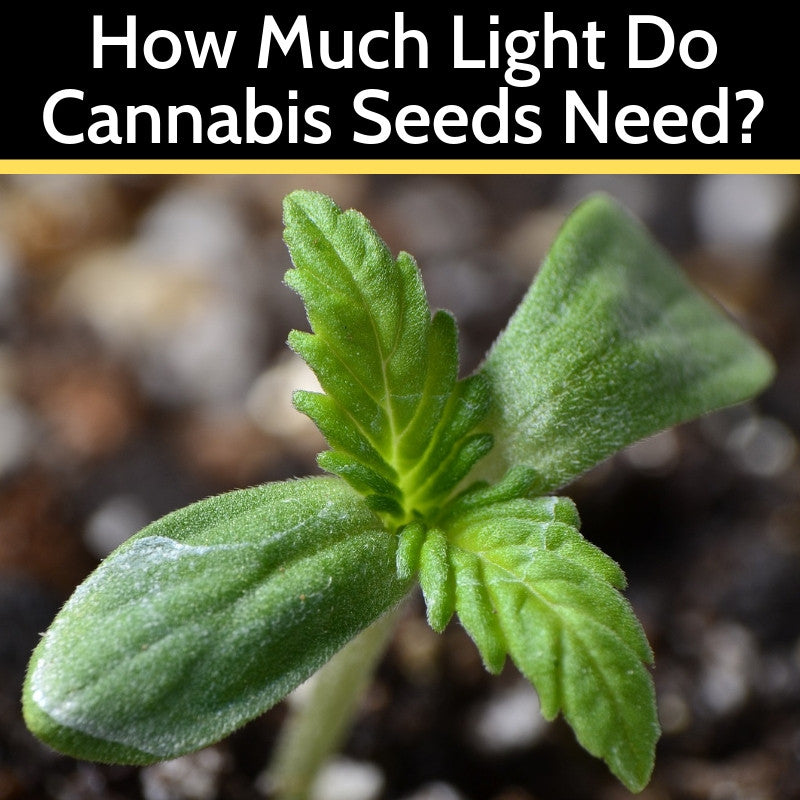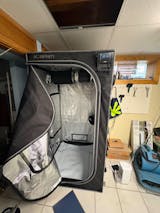Cannabis seeds are expensive.
You want to make sure they sprout, because any seeds that go to waste cost you a lot of money.
To maximize the chance of success, seeds need the right conditions.
They need the right amount of light, the correct temperature, and the correct amount of moisture.
If you provide what they want, the chances of successful germination skyrocket.
If you do not provide the ideal conditions, the chances of success plummet.
We'll tell you exactly what you need to do to give your weed seeds the best chance at becoming a strong and healthy marijuana plant. And we'll start with the question that likely brought you here: the light requirements.
Note: If you're looking to buy seeds, we highly recommend getting them from ILGM*.
How Much Light Do Cannabis Seeds Need?
Cannabis seeds need no light when they are germinating. In fact, they require an absence of light. All of the methods below call for darkness.
Once they have sprouted, they will need a lot of light—18 hours a day, to be exact (though you could even give them 24 hours of light per day).
How To Germinate Cannabis Seeds

There are several methods for germinating marijuana seeds, each with its pros and cons. We will cover the best methods below, with the first method offering the best chance of success and the last one offering the lowest chance.
These seeds are expensive, so we recommend using the method with the best chance of success to reduce the risk of wasting seeds as much as possible.
Germinating Cannabis Seeds In A Propagator With Peat Pellets
Providing the perfect environment for germination increases the success rate. A propagator ensures optimal control over the environment.
Pros
- Best chance of success
- Once you have the propagator, you can keep reusing it
Cons
- Need for equipment/higher startup cost
- Not as simple as some other methods
There are various types of propagators on the market: some just have a plastic dome, some have seed starter trays, some have heating pads, and some even include a grow light.
Fill each hole in the seed tray with a peat pellet. You can buy them at any garden store or get them online. This bag of pellets from Jiffy is a great deal.*
To use the pellets, simply soak them in water for around ten minutes. They will expand.
Once expanded, poke a little hole about half an inch (1.5 cm) deep into each pellet. Place one seed in each of the pellets and cover the seed. The seed needs to be beneath the soil in darkness.
Keep the propagator warm, at 68° to 82° F (20° to 28° C), and the seed pellets moist. They can never dry out, or the seed will die.
Note that peat pellets are great for planting in soil or coco coir, but they do not work with a hydroponic setup. For that, you should use rapid rooters.*
Rapid rooters work great for any type of setup, but we prefer peat pellets for non-hydroponic setups because they cost less and do not dry out (since rapid rooters come in bags of 50 or more, if you do not use all 50 fairly soon, the remaining ones will dry out and become useless, though you can reseal them to give yourself a bit more time).
This method ensures a high rate of success whether using peat pellets or rapid rooters, but it does require the purchase of a propagator and the pellets or rapid rooters.
You can save a bit of money by skipping the propagator and just rigging something up yourself (or not using any type of covering at all), which is what we'll cover next.
Using Peat Pellets With No Propagator (Or With A DIY Propagator)
If you are on a bit of a budget, you can forgo the propagator and just use peat pellets on their own. You could even make a DIY propagator by simply using some kind of plastic cover.
Pros
- Lower cost than using a propagator
- Peat pellets (or rapid rooters) still offer the best chance of success, even without a propagator
Cons
- Less control than with the propagator
- If using a DIY propagator, it requires time to construct
A great DIY solution is to use simple plastic cups, one for each peat pellet. Cut the top off a small plastic drink bottle and place it over the peat pellet with the seed as a dome.
But you don’t need any propagator at all.
Covering the seeds helps keep in the moisture and makes it easier to keep them warm, but it is not necessary. You can just as easily keep the peat pellets uncovered, as long as you ensure they stay moist and are kept in the correct temperature range.
Germinating Cannabis Seeds Using Paper Towels
This is probably the most written-about method, but that does not make it the best. It is easy and does not require any additional equipment, but it requires handling the delicate seedling.
Pros
- Very easy
- No additional equipment required (assuming you have paper towels)
Cons
- Requires transplanting the seeds, which risks damage
- Need to ensure the paper towel stays damp, but not wet
The only thing you need for this method is a paper towel, although I recommend using two plates.
For the paper towel, you should use the cheapest brands of paper towels. More expensive towels are more porous, which makes it easier for the delicate root to get stuck and tear off when transplanting the seedling.
For this method, place a paper towel on a plate and wet it. Drain off any excess water, though. The towel should be damp, but there should be no standing water, or the seeds can drown.
Put your seeds on one half of the paper towel and fold the other half over them, so that they are covered. Then take the second plate and put it upside down on the bottom one, forming a dark cavern between the two plates for the seed to germinate.
Check once or twice a day to ensure that the paper towel never dries out. If you need to add water, always drain out any standing water. Keep the seeds covered and at the correct temperature. They should sprout in a few days.
Once they have sprouted, you’ll want to transfer them to soil or a growing medium. See below for instructions on how to do this.
Germinating Weed Seeds In Soil
This method is the easiest, since you simply let the seeds germinate in the same place where they will grow afterward. Not having to transplant the seed after it sprouts means you don’t risk damaging it, causing it shock that will slow growth. The main drawback is a lower success rate.
Pros
- Easiest method
- No transplanting required
- no additional equipment required
Cons
- Lower success rate than other methods
For this method, you poke a hole in the soil or growing medium about half an inch deep (1.5 cm), place the seed in the hole, and cover it up. Ensure that the soil or growing medium is moist but not soaking wet. The temperature needs to be in the correct range as well.
Germinating Marijuana Seeds In Water
This is another easy method, but it does require transplanting the seeds once they have sprouted.
Pros
- Very easy
- No additional equipment required
Cons
- Lower success rate
- Often, seeds will not sprout in time, and you will need to use a different method as a backup (or lose the seed)
For this method, simply fill a glass with warm water and drop the seeds inside. Store in a dark and warm place for 12 to 24 hours.
You should see the tap root poking out of the seeds by then. If not, you’ll want to continue germinating the seeds elsewhere, perhaps in soil. If they are submerged in water for more than 24 hours, there is a risk that the seeds can drown.
My Seeds Germinated, Now What?
Once the seeds have germinated, it is time to transplant them into soil or a growing medium. Be very careful not to damage the delicate taproot. Ideally, use tweezers to handle the seeds to avoid any oils from your fingers damaging them.
Plant the seeds about 1 to 2 cm deep so that the stem and first leaves do not require too much energy to pop up through the soil.
Make sure the soil is moist and the seeds are kept at the correct temperature of 68° to 82° F (20° to 28° C). Your little plants should pop out of the soil within a few days.
At this point, the seeds will want light, and lots of it. Even if they are still beneath the soil, you can turn on your grow light.
If you do not have a grow light, there are several different types you can consider. For seedlings, fluorescent lights or LED light bars (like the HLG Propagator Cloning Lamp) are ideal, unless you are germinating a lot of seeds at once. Then, you might want to consider a larger LED grow light.
Best LED Grow Lights For Starting Seeds
The best LED grow light for seedlings is the NextLight Veg8 Pro. It was especially designed for seedlings, clones, and vegging, with a separate "clone" mode for clones and seedlings. The main drawback is that it is made to cover a 2-by-4-foot area. If you only have a few seedlings, this light will be overkill.
LED bars are the best LED lights for seed starting when you don’t have enough seedlings to fill a 2-by-4-foot area. The Secret Jardin bar is a great choice. It is inexpensive and will give off enough light to get your plants through the seedling stage in no time.
HPS Or MH For Seedlings
You can put seedlings under HPS or MH light, but I would only suggest this if you already have the lights. It is more cost-effective to use LED or fluorescent lights.
The only time MH or HPS really makes sense is if you keep your plants in the same space from seed to harvest, i.e., you do not have a separate area for seedlings.
Metal halide light is better for seedlings than HPS light, since they need cooler light with more blue light than red.
When To Put Seedlings Under MH or HPS
You can turn the grow light on once the seeds have sprouted and they are in the soil or growing medium. Even if the plant is still not visible, the heat from the grow light will actually help warm the soil, which encourages the plant to grow.
How Long From Seedling To Vegetative
Seedlings usually transition to vegetative growth in 10 to 15 days, but it is difficult to give an exact timeline. It just varies so much from one strain to the next and from one growing environment to the next.
How Long Do Weed Seeds Last?
If stored correctly, marijuana seeds could last up to 5 or 6 years. That said, the older they get, the lower the chance of successful germination and the longer it takes, even if it is successful.
For the best results, store your seeds in a cool, dark place. A basement or refrigerator works well. We recommend these storage containers.










Comments
Leave a comment